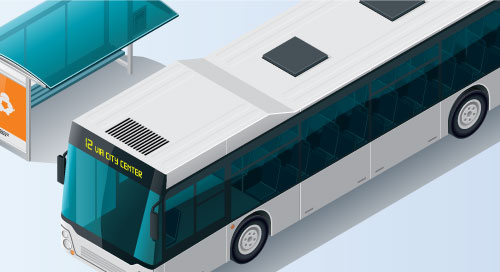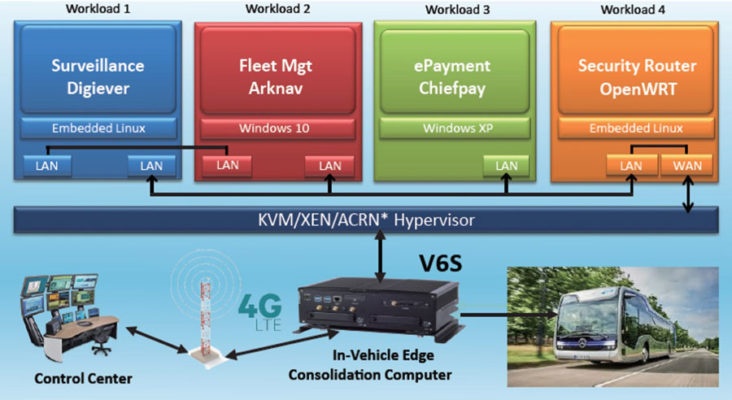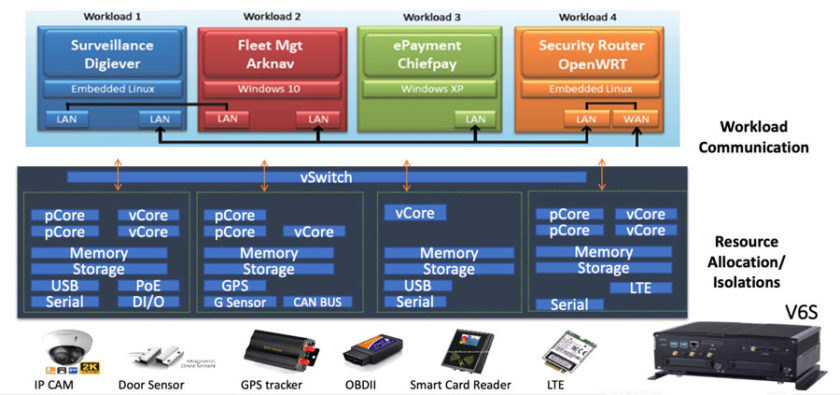A Faster Route to Smart Transportation

The trend toward workload consolidation—running multiple application on a single computing platform—is essential to building a smart factory.
It’s not surprising that the same model applies to smart transportation. Like factories, public transportation vehicles run a variety of applications on separate proprietary hardware platforms and multiple operating systems. A city bus, for example, might have surveillance cameras, an ePayment system, and fleet management sensors on board—all running independently.
And just as in manufacturing operations, integrating these functions on citywide buses, for example, would reduce operating costs, improve safety, and enable centralized monitoring.
One company that is working to make smart transit a possibility is Lanner Electronics, Inc., with its V6S10-Port PoE Fanless Vehicle NVR solution. Rather than using multiple proprietary control systems, the open platform provides the ability to bring disparate functions into the same box as shown in Figure 1.

Smart Transportation Proof of Concept
Maintaining one open platform is easier than keeping multiple systems up-to-date and operational. With this configuration, legacy applications and OSs can run alongside modern software. Hence, any software can be integrated onto the platform, providing ample flexibility for systems integrators. Such flexibility supports customization and optimization of systems as well, as different workload configurations can be created for niche applications.
“There’s not really any kind of solution like this today, so we developed it as a proof of concept,” said Brian Chen, Marketing Manager at Lanner Electronics. “We built this platform and are working with other vendors to integrate their software as workloads. For example, we have an AI company doing the facial recognition and video analytics.”
Another bonus is that the pace of innovation can be accelerated. System developers currently have to absorb the hardware design costs. In this scenario, these companies can focus their efforts on developing value-added software. The single hardware platform can be upgraded via software to deploy new functionality, lowering the cost of introducing new technology and accelerating time to market.
You have all these different types of workloads that in theory you can just keep adding—legacy or more-modern operating systems—within the hypervisor context. @lannerinc @insighdottech
Virtualizing Workloads
The four workloads shown above run on a single platform—managed by a Redhat KVM hypervisor, which is responsible for virtualization of the workloads as well as allocating access to resources like cameras, sensors, and other devices.
“You have all these different types of workloads that in theory you can just keep adding—legacy or more-modern operating systems—within the hypervisor context,” said Chen.
Through virtualization, these independent applications can be converted into workloads that can then be consolidated under a single hypervisor. Through management of the hypervisor, all I/O capabilities of the system can be assigned to each workload as required by each OS/application—without extensive and costly software porting (Figure 2).

The V6S is built on the Intel® Core™ i7-7600U dual core processor. Depending on the number and complexity of workloads running, more computing resources may be required. Lanner is already exploring four- and six-core implementations to meet the needs of various transportation applications. For example, intelligent buses will be able to consolidate passenger information management, digital signage, job dispatch, GPS tracking, emergency systems, and more.
And Lanner offers a full range of open, interoperable uCPE platforms that deliver multi-core computing power, virtualization, optimized throughput, crypto acceleration engines, and Wi-Fi/LTE/5G-ready connectivity.
Consolidating workloads can result in significant cost savings. For example, in this proof-of-concept, the various systems that have been consolidated cost $2,450 when implemented independently. A single Lanner V6S consolidating these workloads costs $1,500. In addition, deployment and maintenance costs are lower.
Keeping the Legacy OS and System Software
The flexibility to use legacy software and operating systems, side by side with modern applications, is an important factor for the transportation industry. Most public transport vehicles have a long operating life. Workload consolidation and virtualization extend the life of legacy systems, maximizing initial vehicle investment and increasing the time between essential—and expensive—system upgrades.
Consolidation also opens tremendous flexibility for aftermarket enhancements. It takes a great deal of work to certify the systems that come standard with a vehicle. With an open workload platform, new features can be sold after-market. This allows vehicles to come to market faster while opening them as a platform for which industry third parties can innovate.
“In the end, we’re working to show the possibilities when developers don’t need to spend time and money to move software from old to new environments,” said Chen. “Workloads can be consolidated at the edge with high-performance compute. And this can create new opportunities in many industries—from manufacturing to transportation.”